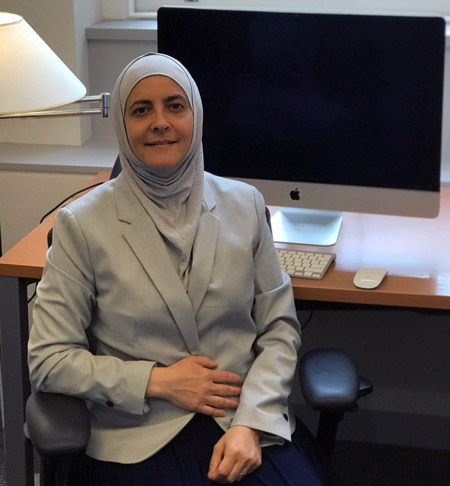Using AI to control energy for indoor agriculture
30 September 2024
Published online 31 July 2018
Drawing on her experience establishing a state-of-the art lab in Jordan using minimal resources, Rana Dajani discusses her role in world-class research.

Courtesy of Rana Dajani
As researchers in developing countries, it’s time we searched for unique research questions that can only be answered within our context.
I graduated from the University of Iowa as a Fulbright scholar, and coming back to Jordan, I quickly realized that I could not continue my investigation into signalling transduction, because it required very expensive technology. Back then, I had two options: either limit my research scope by tailoring it to the budget and technology available in my home country, or go back to the US.
I ended up doing neither. I was trained by the best and I wanted to continue to do great science in Jordan. I also wanted to establish my own lab.
Like any scientist worth her salt, I rolled up my sleeves, and got to work — guided by the adage, “research is seeing what everybody else has seen and thinking what nobody has thought”.
I started reading extensively in search for a possible answer to the million-dollar question. What can I contribute to science that no one else could? What can someone from Jordan add or innovate that no one in another more advanced university lab or country could not?
I unfailingly kept up with the latest advancements in my field in search for a niche, or a wild card that would allow me to compete at the international level in the scientific arena. The human genome had been sequenced a few years ago, and the HapMap was out. But then, during my search, I stumbled upon a story where new genes using genome-wide association studies (GWAS) in the genetically isolated population of Iceland were discovered.
I felt I struck gold. That was back in 2007.
In Jordan, we have two similar genetically-isolated populations: Circassians and Chechens. These populations have been isolated geographically and culturally for more than one thousands years in their respective regions, and for the past 140 years in Jordan. These populations are unique and fragile; older members are dying and younger ones are marrying outside the populations, compromising their gene pools.
I found the area of research that would allow me to contribute to world-class science, I thought. I decided to rigorously study the genomes of these two populations.
I collaborated with an anthropologist, biochemist, and epidemiologist, putting together a team of scientists from different fields of expertise, universities and centres of research in a region where multidisciplinary studies and collaborations, initiated by local scientists, are uncommon.
I established my own lab, immediately drafting two grant proposals. I was finally able to obtain two relatively generous grants. My team and I opted for an inclusive approach recruiting scientists from the two communities under scrutiny.
We surveyed both communities, simultaneously offering medical advice, blood testing and full pedigree analysis. Everyone was extremely cooperative and enthusiastic.
We created a DNA data bank for both populations in addition to producing 10 articles describing the populations in relation to diseases like diabetes, metabolic syndrome, and hypertension. We also conducted GWAS and whole genome copy number variation (CNV) analysis and discovered a new genetic risk factor for diabetes.
We established ties with the Children's Hospital of Philadelphia’s genome centre CHOP that later developed into a lifelong collaboration on DNA analysis. Contrary to the norm in the region, where research is often initiated in the West and scientists from developing countries are co-opted, this collaboration began in Jordan and was initiated by our lab.
It was through this method that I established myself and my team as world experts on these two populations, thereby creating a competitive niche.
Over the years, I was approached by other scientists of the calibre of Rasmus Nielsen at UC Berkeley, US, and Eske Willerslev at University of Copenhagen, Denmark to combine our DNA bank to his own study on ancient human lineages and human migrations across Eurasia because of our expertise on modern people from the region. This ultimately resulted in two Nature publications in June1.
My team and I have also been able to serve the two communities we studied through sharing DNA information and data, in addition to phylogeny trees in an effort to help preserve their ethnicity, history and culture, while acknowledging their contribution to science and to the advancement of human health.
We are still using our DNA database and there are many questions that we have yet to answer and share, but this is one example of how changing the question, and one’s outlook and approach, can yield fruit in collaboration, funding and research experience.
The journey certainly had its challenges, but persistence, and thinking creatively about one’s field of research, can create great change, and can perhaps free us of the bottleneck of waiting for funding or to be recruited by internationals. Great opportunity emerges from working on questions that make us unique and meet our populations’ needs.
Rana Dajani is an associate professor of molecular cell biology at the Hashemite University in Jordan, a Radcliffe fellow at the University of Harvard, and an authority on the genetics of the Circassian and Chechen populations in Jordan. Her research focuses on the genetics of diabetes and stem cells, as well as epigenetics and biomarkers of trauma in refugee contexts.
doi:10.1038/nmiddleeast.2018.88
Stay connected: